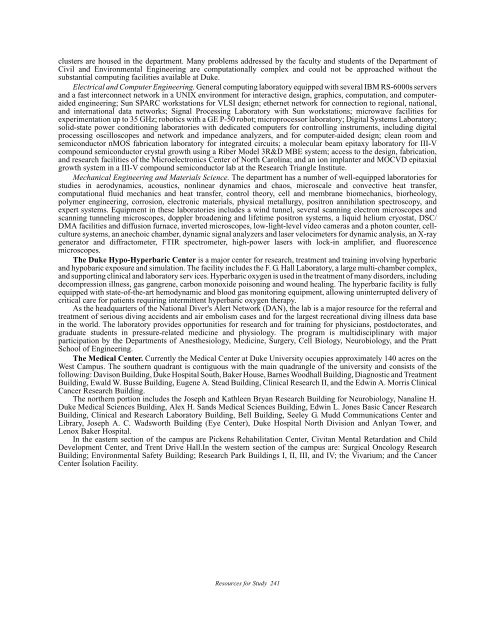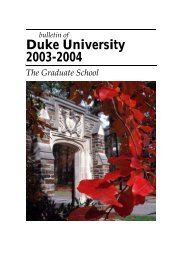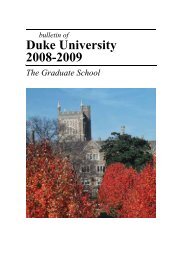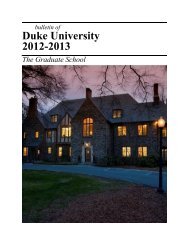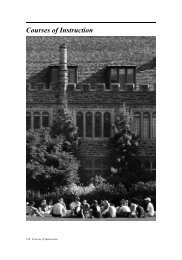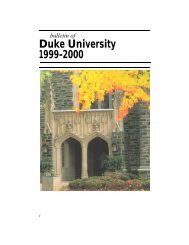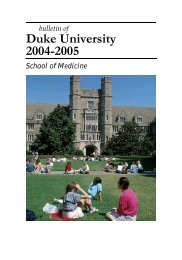Duke University 2009-2010 - Office of the Registrar - Duke University
Duke University 2009-2010 - Office of the Registrar - Duke University
Duke University 2009-2010 - Office of the Registrar - Duke University
You also want an ePaper? Increase the reach of your titles
YUMPU automatically turns print PDFs into web optimized ePapers that Google loves.
clusters are housed in <strong>the</strong> department. Many problems addressed by <strong>the</strong> faculty and students <strong>of</strong> <strong>the</strong> Department <strong>of</strong><br />
Civil and Environmental Engineering are computationally complex and could not be approached without <strong>the</strong><br />
substantial computing facilities available at <strong>Duke</strong>.<br />
Electrical and Computer Engineering. General computing laboratory equipped with several IBM RS-6000s servers<br />
and a fast interconnect network in a UNIX environment for interactive design, graphics, computation, and computeraided<br />
engineering; Sun SPARC workstations for VLSI design; e<strong>the</strong>rnet network for connection to regional, national,<br />
and international data networks; Signal Processing Laboratory with Sun workstations; microwave facilities for<br />
experimentation up to 35 GHz; robotics with a GE P-50 robot; microprocessor laboratory; Digital Systems Laboratory;<br />
solid-state power conditioning laboratories with dedicated computers for controlling instruments, including digital<br />
processing oscilloscopes and network and impedance analyzers, and for computer-aided design; clean room and<br />
semiconductor nMOS fabrication laboratory for integrated circuits; a molecular beam epitaxy laboratory for III-V<br />
compound semiconductor crystal growth using a Riber Model 3R&D MBE system; access to <strong>the</strong> design, fabrication,<br />
and research facilities <strong>of</strong> <strong>the</strong> Microelectronics Center <strong>of</strong> North Carolina; and an ion implanter and MOCVD epitaxial<br />
growth system in a III-V compound semiconductor lab at <strong>the</strong> Research Triangle Institute.<br />
Mechanical Engineering and Materials Science. The department has a number <strong>of</strong> well-equipped laboratories for<br />
studies in aerodynamics, acoustics, nonlinear dynamics and chaos, microscale and convective heat transfer,<br />
computational fluid mechanics and heat transfer, control <strong>the</strong>ory, cell and membrane biomechanics, biorheology,<br />
polymer engineering, corrosion, electronic materials, physical metallurgy, positron annihilation spectroscopy, and<br />
expert systems. Equipment in <strong>the</strong>se laboratories includes a wind tunnel, several scanning electron microscopes and<br />
scanning tunneling microscopes, doppler broadening and lifetime positron systems, a liquid helium cryostat, DSC/<br />
DMA facilities and diffusion furnace, inverted microscopes, low-light-level video cameras and a photon counter, cellculture<br />
systems, an anechoic chamber, dynamic signal analyzers and laser velocimeters for dynamic analysis, an X-ray<br />
generator and diffractometer, FTIR spectrometer, high-power lasers with lock-in amplifier, and fluorescence<br />
microscopes.<br />
The <strong>Duke</strong> Hypo-Hyperbaric Center is a major center for research, treatment and training involving hyperbaric<br />
and hypobaric exposure and simulation. The facility includes <strong>the</strong> F. G. Hall Laboratory, a large multi-chamber complex,<br />
and supporting clinical and laboratory serv ices. Hyperbaric oxygen is used in <strong>the</strong> treatment <strong>of</strong> many disorders, including<br />
decompression illness, gas gangrene, carbon monoxide poisoning and wound healing. The hyperbaric facility is fully<br />
equipped with state-<strong>of</strong>-<strong>the</strong>-art hemodynamic and blood gas monitoring equipment, allowing uninterrupted delivery <strong>of</strong><br />
critical care for patients requiring intermittent hyperbaric oxygen <strong>the</strong>rapy.<br />
As <strong>the</strong> headquarters <strong>of</strong> <strong>the</strong> National Diver's Alert Network (DAN), <strong>the</strong> lab is a major resource for <strong>the</strong> referral and<br />
treatment <strong>of</strong> serious diving accidents and air embolism cases and for <strong>the</strong> largest recreational diving illness data base<br />
in <strong>the</strong> world. The laboratory provides opportunities for research and for training for physicians, postdoctorates, and<br />
graduate students in pressure-related medicine and physiology. The program is multidisciplinary with major<br />
participation by <strong>the</strong> Departments <strong>of</strong> Anes<strong>the</strong>siology, Medicine, Surgery, Cell Biology, Neurobiology, and <strong>the</strong> Pratt<br />
School <strong>of</strong> Engineering.<br />
The Medical Center. Currently <strong>the</strong> Medical Center at <strong>Duke</strong> <strong>University</strong> occupies approximately 140 acres on <strong>the</strong><br />
West Campus. The sou<strong>the</strong>rn quadrant is contiguous with <strong>the</strong> main quadrangle <strong>of</strong> <strong>the</strong> university and consists <strong>of</strong> <strong>the</strong><br />
following: Davison Building, <strong>Duke</strong> Hospital South, Baker House, Barnes Woodhall Building, Diagnostic and Treatment<br />
Building, Ewald W. Busse Building, Eugene A. Stead Building, Clinical Research II, and <strong>the</strong> Edwin A. Morris Clinical<br />
Cancer Research Building.<br />
The nor<strong>the</strong>rn portion includes <strong>the</strong> Joseph and Kathleen Bryan Research Building for Neurobiology, Nanaline H.<br />
<strong>Duke</strong> Medical Sciences Building, Alex H. Sands Medical Sciences Building, Edwin L. Jones Basic Cancer Research<br />
Building, Clinical and Research Laboratory Building, Bell Building, Seeley G. Mudd Communications Center and<br />
Library, Joseph A. C. Wadsworth Building (Eye Center), <strong>Duke</strong> Hospital North Division and Anlyan Tower, and<br />
Lenox Baker Hospital.<br />
In <strong>the</strong> eastern section <strong>of</strong> <strong>the</strong> campus are Pickens Rehabilitation Center, Civitan Mental Retardation and Child<br />
Development Center, and Trent Drive Hall.In <strong>the</strong> western section <strong>of</strong> <strong>the</strong> campus are: Surgical Oncology Research<br />
Building; Environmental Safety Building; Research Park Buildings I, II, III, and IV; <strong>the</strong> Vivarium; and <strong>the</strong> Cancer<br />
Center Isolation Facility.<br />
Resources for Study 241


